
Detroit Dam is a gravity dam on the North Santiam River between Linn County and Marion County, Oregon. It is located in the Cascades, about 5 mi (8.0 km) west of the city of Detroit. It was constructed between 1949 and 1953 by the United States Army Corps of Engineers. The dam created 400-foot (120 m) deep Detroit Lake, more than 9 miles (14 km) long with 32 miles (51 km) of shoreline.

The Interstate Bridge is a pair of nearly identical steel vertical-lift, Parker through-truss bridges that carry Interstate 5 traffic over the Columbia River between Vancouver, Washington and Portland, Oregon in the United States.

The Alerus Center is an indoor arena and convention center in the north central United States, located in Grand Forks, North Dakota. The facility is owned and operated by the city of Grand Forks and opened on February 10, 2001.
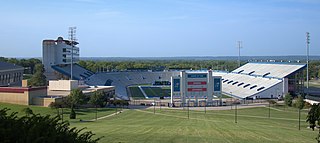
David Booth Kansas Memorial Stadium is a football stadium located in Lawrence, Kansas, on the campus of the University of Kansas. The stadium was opened in 1921, and is the seventh oldest college football stadium in the country, and is widely recognized as the oldest west of the Mississippi River. Nicknamed "The Booth", the stadium is dedicated as a memorial to Kansas students who died in World War I, and is one of seven major veterans' memorials on the campus. The stadium is at the center of all seven war memorials - adjacent to the stadium, further up the hill is a Korean War memorial honoring Kansas students who served, just a few hundred feet south of the stadium stands the University of Kansas World War II Memorial, the Kansas Memorial Campanile and Carillon, the University of Kansas Vietnam War Memorial sits adjacent to the Campanile to the west, the Victory Eagle - World War I statue located on Jayhawk Boulevard, southeast of the stadium, and the Kansas Memorial Union, a veterans' memorial that also houses the main university student union and bookstore, located east of the stadium. The stadium is the home stadium of the Kansas Jayhawks football team.
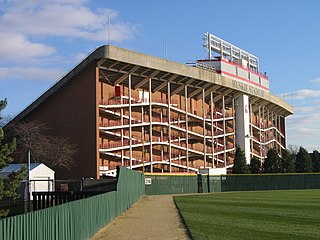
Brigham Field at Huskie Stadium is a college football stadium in the central United States, located on the campus of Northern Illinois University in DeKalb, Illinois. Opened 58 years ago in 1965, it is the home field of the NIU Huskies of the Mid-American Conference (MAC).
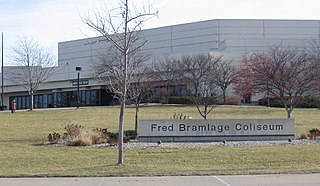
Fred Bramlage Coliseum is a multi-purpose indoor arena in Manhattan, Kansas, with an official capacity of 11,000. It is the home to the Kansas State University men's and women's basketball teams, and serves as an alternate venue for Kansas State's women's volleyball team. The facility currently holds offices for various administrative and business units for K-State Athletics, and the track & field team. Bramlage was previously the home for other K-State team offices, including women's soccer and baseball.

The Littlejohn Coliseum is a 9,000-seat multi-purpose arena in Clemson, South Carolina, United States. It is home to the Clemson University Tigers men's and women's basketball teams. It is also the site of Clemson graduations and the Clemson Career Fair. It is owned and operated by Clemson University and hosts more than 150 events per year including concerts, trade shows, galas, and sporting events.

FNB Field is a baseball park in Harrisburg, Pennsylvania, on City Island in the Susquehanna River. It is the home field of the Harrisburg Senators, the Double-A Eastern League affiliate of the Washington Nationals, and was the home stadium of Penn FC of the USL. The original structure was built in 1987 and it was called Riverside Stadium until 2004. It has a capacity of 6,187. The ballpark received a $45 million renovation that began in 2008.

James A. Rhodes Arena, nicknamed "The JAR," is an arena in Akron, Ohio, United States on the campus of the University of Akron. It was built next to and replaced the University's 3,000-seat Memorial Hall gymnasium. Named for former Ohio governor Jim Rhodes, the arena opened in 1983 and is home to the Akron Zips men's and women's basketball teams and women's volleyball team.
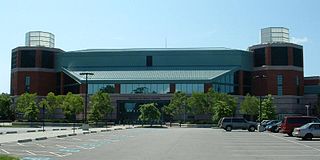
Ryan Center is an 8,000-seat multi-purpose arena in Kingston, Rhode Island. The arena opened as a replacement for Keaney Gymnasium, which was built in 1953 for the needs of a much smaller student population at URI. It is home to the University of Rhode Island Rams basketball. The building is named for Thomas M. Ryan, Class of 1975, former CEO of Rhode Island-based CVS Pharmacy and lead benefactor of the arena.

The Orange County Convention Center is a convention center located in Orlando, Florida. Opened in 1983 as the Orange County Convention and Civic Center, it is the primary public convention center for the Central Florida region and the second-largest convention center in the United States, after McCormick Place in Chicago.

The Kress Events Center, also known as the KEC or the Kress, is a multipurpose athletic facility located in Green Bay, Wisconsin on the University of Wisconsin–Green Bay campus. The facility's main gym hosts the UW-Green Bay women's basketball and volleyball teams. Other facilities onsite include a fitness center shared by athletes and the student body, athletic training facilities, and the administrative offices of UW-Green Bay's athletics program.

The Stroh Center is a multi-purpose arena on the campus of Bowling Green State University in Bowling Green, Ohio, United States. It replaced Anderson Arena as the home of the Bowling Green Falcons men's and women's basketball and women's volleyball teams, and hosts music concerts and the university's commencement ceremonies. The arena was designed by the architectural firm Rossetti Architects, designers of Red Bull Arena and Rio Tinto Stadium, and engineering firm URS Group Inc. The building opened in September 2011 and seats 4,387 people for basketball and volleyball games and 5,209 for convocation events and concerts.

College Park Center (CPC) is an indoor, multi-purpose arena on the University of Texas at Arlington campus in Arlington, Texas, United States. It seats up to 7,000 spectators.

The Claverack Free Library is located on NY 23B near the center of the hamlet of Claverack-Red Mills, New York, United States. It is located in the renovated former A.B. Shaw Firehouse.
Suncoast Credit Union Arena is a 75,000 sq ft (7,000 m2) multipurpose arena on the campus of Florida SouthWestern State College (FSW) in Fort Myers, Florida. It is the home of the FSW Buccaneers men's and women's basketball and volleyball teams. It holds 3,500 people in basketball configuration. It also features six skyboxes, a hospitality event center, competition courts that convert into recreational courts, athletic office space, student, faculty and staff wellness, and an athletic center with a fitness pavilion, men's and women's locker rooms and a weight training area. It is also the home to the City of Palms Classic, an annual high school basketball tournament.

Robinson Gymnasium was the first true gymnasium for the University of Kansas (KU) in Lawrence, Kansas and home to the Kansas Jayhawks men's basketball program from 1907 to 1927. It was designed by James Naismith at a cost of $100,000. The creation of the modern facilities were led by Naismith and Chancellor Frank Strong. Naismith wanted the gymnasium not just for basketball but also for his other physical education classes and sports activities. The gymnasium was named after Charles L. Robinson, who was the first Governor of Kansas, and his wife Sara Tappan Doolittle Robinson, both as thanks for their service and to make amends for what Sara perceived to be excessive pressure on her nephew to sell 51 acres (21 ha) of land to KU at a below-market price. Construction began in 1905 and was completed in May 1907.

The Community First Champion Center is a 164,000 sq ft (15,200 m2) indoor sports center in Grand Chute, in the U.S. state of Wisconsin. The facility is primarily intended to be used for youth sports/community sporting activities and as of early 2019 is not planned to house a professional sports team.
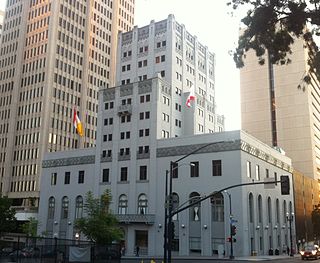
The building traditionally known as the San Diego Athletic Club is a historic building located in Downtown San Diego. It was built in 1928 as a private athletic club, was converted to office buildings in the 1960s, was converted to a city center in 1994, and became a homeless shelter and community medical facility in the 2010s.




















